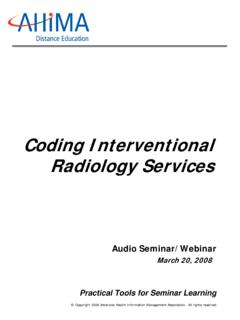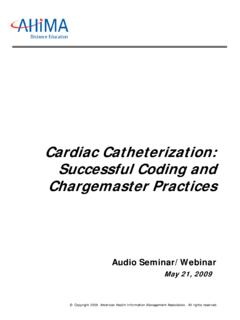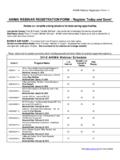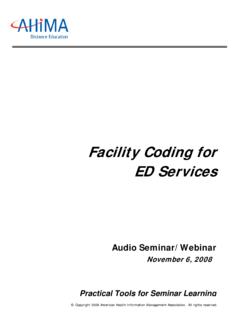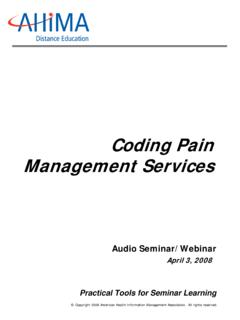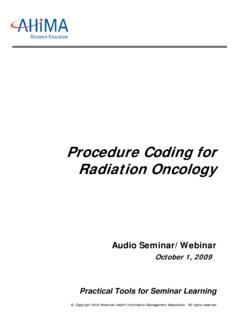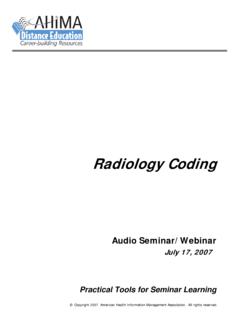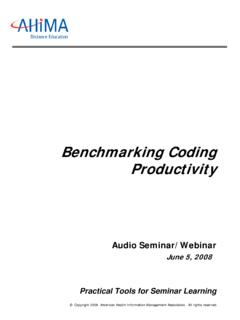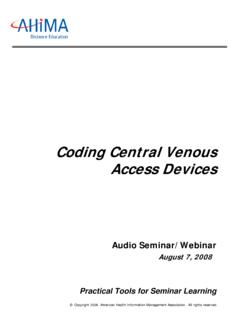Transcription of Basic ICD-10-CM/PCS Coding - AHIMA
1 Basic ICD-10-CM/PCS Coding 2013 Edition Answer Key Lou Ann Schraffenberger, MBA, RHIA, CCS, CCS-P, FAHIMA Answer Key The answer key includes the correct ICD-10-CM/PCS codes and the Alphabetic Index entry used to locate each code. Chapter 1 Introduction to ICD-10-CM Exercise 1. N63 Mass, breast 2. Hydronephrosis (primary) 3. Deviated, nasal septum 4. Adenopathy, inguinal 5. Disease, arteriosclerotic see Disease, heart, ischemic, atherosclerotic. Arteriosclerotic heart see Arteriosclerosis, coronary (artery) 6. Headache, tension 7. Pancreatitis (suppurative) 8. Eruption, tooth abnormal (premature) 9. Endocarditis, infectious 10. Endocarditis, mitral with aortic (valve) disease, active or acute Exercise 1. Nonessential modifier = congenital Distortion (congenital) chest (wall) 2. Nonessential modifier=acute Diverticulitis (acute) intestine, large 3. Nonessential modifier = bleeding Hemorrhoids external 4.
2 Nonessential modifier=cardiac Murmur (cardiac) functional 5. Nonessential modifier=chronic Sinusitis (chronic) maxillary Exercise 1. Main term=Endomyometritis Endomyometritis see Endometritis, acute 2. Main term=Metrorrhexis Metrorrhexis see Rupture, uterus, nontraumatic 3. Main term=Osteoarthrosis Osteoarthrosis see also Osteoarthritis, shoulder, (unspecified = ) 4. Main term=Prolapse Prolapse see Displacement, intervertebral disc, cervical 5. Main term=Stenosis Stenosis, endocervical see Stenosis cervix Exercise 1. Sepsis NOS 2. Infection, bacteroides NEC 3. Pericarditis (with effusion) 4. Disease, fifth Tabular List Erythema infectiosum [fifth disease] 5. Dementia, with, Lewy bodies [ ] See the "Use additional code" note under category G31 Use additional code to identify dementia with behavioral disturbance ( ) Use additional code to identify dementia without behavioral disturbance ( ) Exercise 1.
3 Intrahepatic bile duct 2. Diabetes mellitus arising in pregnancy Gestational diabetes mellitus 3. Anorexia nervosa 4. Blackout, Fainting, Vasovagal attack 5. Diverticulum of appendix Exercise 1. Varix, esophagus, in, cirrhosis of liver, bleeding 2. Infection, urinary (tract) Use additional code (B95 B97) to identify infectious agent Infection, Escherichia coli as cause of disease classified elsewhere 3. Ulcer, duodenum, acute, with hemorrhage 4. Anemia, due to, prematurity 5. Examination, following, motor vehicle accident Review Exercises: Chapter 1 1. Appendicitis, acute, with perforation 2. Pneumonia, streptococcal NEC 3. Pain, chest, precordial 4. Cor, pulmonale, acute 5. Osteoarthrosis see Osteoarthritis, primary, ankle, right 6. Goiter, nodular, toxic 7. Extra see Accessory, thyroid 8. Angiodysplasia (colon) with bleeding 9. Tracheobronchitis see also Bronchitis, acute 10.
4 Disease, heart, arteriosclerotic see Disease, heart, ischemic, atherosclerotic with angina pectoris see Arteriosclerosis, coronary (artery) native vessel with angina pectoris 11. Nephritis, due to, systemic lupus erythematosus 12. Prenatal, care, normal first pregnancy see Pregnancy, normal, first, second trimester 13. Fracture, femur, upper end, intertrochanteric, left The coder must see the Tabular List for assignment of the left side and the seventh character A for the closed fracture, initial encounter to identify the encounter. 14. Prostatitis, trichomonal 15. Occlusion, artery, carotid, with cerebral infarction I10 Hypertension (essential) 16. , Hepatitis, C, acute, with hepatic coma 17. , Leukemia, acute lymphoblastic, see Tabular List for sixth character for in remission 18. , Tumor, carcinoid, benign, appendix 19. , Enlarged, prostate, with lower urinary tract symptoms (urinary obstruction) verified in Tabular List under code Obstruction, urinary, specified.
5 Inclusion notes under state urinary obstruction due to specified cause and there is a code first note present to code the causal condition such as enlarge prostate Corrected from Alphabetic Index: , Obstruction, urinary 20. , History, personal, malignant neoplasm (of), breast Chapter 2 Introduction to ICD-10-PCS Review Exercises: Chapter 2 1. Answer: 0 DJO8ZZ Character Code Explanation Section 0 Medical and Surgical Body System D Gastrointestinal System Root Operation J Inspection Body Part 0 Upper Intestinal Tract Approach 8 Via Natural or Artificial Opening Endoscopic Device Z No Device Qualifier Z No Qualifier INDEX: Root Operation: Inspection. Index: Esophagogastroduodenoscopy (0DJ08ZZ) In this example, the complete seven character code is listed in the Index. The code still must be confirmed using the code Tables. EGD is an inspection procedure when no other procedures, such as a biopsy or excision, are performed with the EGD.
6 Body part inspected is the upper intestinal tract. Approach is through the mouth so via natural or artificial opening endoscopic is the choice for this procedure. 2. Answer: 0 HBU0ZZ Character Code Explanation Section 0 Medical and Surgical Body System H Skin and Breast Root Operation B Excision Body Part U Breast, Left Approach 0 Open Device Z No Device Qualifier Z No Qualifier INDEX: When consulting the Index, the main term Mastectomy has two subterms: see Excision, Skin and Breast and see Resection, Skin and Breast. Since only part of the breast was removed, the root operation is Excision. 3. Answer: 041L0KL Character Code Explanation Section 0 Medical and Surgical Body System 4 Lower Arteries Root Operation 1 Bypass Body Part L Femoral Artery, Left Approach 0 Open Device K Nonautologous Tissue Substitute Qualifier L Popliteal Artery INDEX: When consulting the Index, the main term Bypass, subterm Artery, Femoral produced the root operation table of 041.
7 According to ICD-10-PCS guideline procedures: Bypass procedures are coded by identifying the body part bypassed from and the body part bypassed to . The fourth character body part specifies the body part bypassed from, and the qualifier specifies the body part bypassed to. In this example, the bypass was from the femoral artery to the popliteal artery. A cadaver vein graft is the device identified as nonautologous (from another human than patient) tissue substitute. 4. Answer: 0UN24ZZ Character Code Explanation Section 0 Medical and Surgical Body System U Female Reproductive System Root Operation N Release Body Part 2 Ovaries, Bilateral Approach 4 Percutaneous Endoscopic Device Z No Device Qualifier Z No Qualifier INDEX: Lysis see Release. Release, Ovaries, Bilateral (0UN2) Definition of release in ICD10-PCS is freeing a body part from an abnormal physical constraint which also describes a procedure identified as lysis. Two codes are required for this procedure as the same root operation is performed on different body parts as defined by distinct values of the body part character for the root operation release.
8 Laparoscopy is an approach that is percutaneous endoscopic Answer: 0UN74ZZ Character Code Explanation Section 0 Medical and Surgical Body System U Female Reproductive System Root Operation N Release Body Part 7 Fallopian Tubes, Bilateral Approach 4 Percutaneous Endoscopic Device Z No Device Qualifier Z No Qualifier INDEX: Lysis see Release. Release, Fallopian Tubes (0UN7) 5. Answer: 0SG10A1 Character Code Explanation Section 0 Medical and Surgical Body System S Lower Joints Root Operation G Fusion Body Part 1 Lumbar Vertebral Joints, 2 or more Approach 0 Open Device A Interbody Fusion Device Qualifier 1 Posterior Approach, Posterior Column INDEX: Root operation is fusion. Index: Fusion, lumbar vertebrae 2 or more (0SG1). According to the ICD-10-PCS guideline for fusion procedures of the spine, : The body part coded for a spinal vertebral joint(s) rendered immobile by a spinal fusion procedure is classified by the level of the spine ( thoracic).
9 There are distinct body part values for a single vertebral joint and for multiple vertebral joints at each spinal level. According to guideline if an interbody fusion device is used to render the joint immobile (alone or containing other material like bone graft), the procedure is coded with the device value Interbody Fusion Device. The qualifier identifies the combination of the approach and the column. 6. Answer: 0TP98DZ Character Code Explanation Section 0 Medical and Surgical Body System T Urinary System Root Operation P Removal Body Part 9 Ureter Approach 8 Via Natural or Artificial Opening Endoscopic Device D Intraluminal Device Qualifier Z No Qualifier INDEX: Root Operation: Removal. Index: Removal of device from, Ureter (0TP9) The objective of the procedure was to take the stent out of the ureter which matches the definition of removal to take out of off a device from a body part. The approach is by cystoscopy or via natural or artificial opening (urethra) endoscopic.
10 A stent is an intra-luminal device which are devices placed inside tubular body parts. 7. Answer: 0 XMJ0ZZ Character Code Explanation Section 0 Medical and Surgical Body System X Anatomical Region, Upper Extremities Root Operation M Reattachment Body Part J Hand, Right Approach 0 Open Device Z No Device Qualifier Z No Qualifier INDEX: Root Operation: Reattachment. Index: Reattachment, Hand, Right (0 XMJ0ZZ) Index provides a specific code for this operation. The only variable on the Table is the body part being reattached. 8. Answer: 0W9G3ZX Character Code Explanation Section 0 Medical and Surgical Body System W Anatomical Regions, General Root Operation 9 Drainage Body Part G Peritoneal Cavity Approach 3 Percutaneous Device Z No Device Qualifier X Diagnostic INDEX: Root Operation: Drainage Index: Paracentesis, Peritoneal Cavity see Drainage, Peritoneal Cavity (0W9G) The Index includes the procedure of paracentesis to send the coder directly to the correct Coding Table.
